It's all about the classical music composers and their works from the last 400 years and much more about music. Hier erfahren Sie alles über die klassischen Komponisten und ihre Meisterwerke der letzten vierhundert Jahre und vieles mehr über Klassische Musik.
Total Pageviews
Thursday, November 27, 2025
Saturday, November 8, 2025
Franz Liszt: Dante Symphony Premiered on 7 November 1857
by Georg Predota

Franz Liszt, 1858
Enjoying the shores of Lake Como with Marie d’Agoult in 1837, Franz Liszt (1811-1886) immersed himself in a close reading of Dante’s Divine Comedy. The idea of composing a symphony to Dante’s Divine Comedy, one that would combine music, poetry and the visual arts, gradually took shape. Initially, Liszt suggested that the performance might be accompanied by the projection of lanternslides, showing scenes painted by Bonaventura Genelli. Apparently, he even considered “the use of an experimental wind machine at the end of the first movement to evoke the winds of Hell.”
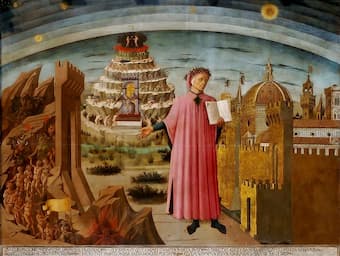
Dante and His Poem by Domenico di Michelino
In the event, in June 1855, Liszt wrote to his future son-in-law Richard Wagner. “So you are reading Dante. He’s good company for you, and I for my part want to provide you with a kind of commentary on that reading. I have long been carrying a Dante Symphony around in my head – this year I intend to finish it. Three movements, Hell, Purgatory and Paradise – the first two for orchestra alone, the last with chorus. When I visit you in the autumn I shall probably be able to bring it with me; and if you don’t dislike it you can let me inscribe your name on it.” Wagner was enthusiastic, but advised against including a choral finale on the grounds that “Paradise could not be depicted in music.”
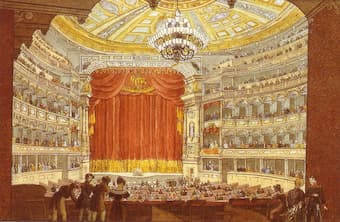
Royal Theatre in Dresden
On the advice of Wagner, Liszt discarded the idea of a choral finale and added a brief setting for women’s voices of the first two verses of the “Magnificat,” all ending with a “Hallelujah.” When Liszt played the Dante symphony for Wagner in Zürich in October 1856, Wagner greatly disliked the fortissimo conclusion. He wrote in his autobiography, “If anything had convinced me of the man’s masterly and poetical powers of conception, it was the original ending of the Faust Symphony, in which the delicate fragrance of a last reminiscence of Gretchen overpowers everything, without arresting the attention by a violent disturbance. The ending of the Dante Symphony seemed to me to be quite on the same lines, for the delicately introduced “Magnificat” in the same way only gives a hint of a soft, shimmering Paradise. I was the more startled to hear this beautiful suggestion suddenly interrupted in an alarming way by a pompous, plagal cadence. No! I exclaimed loudly, not that, away with it! No majestic Deity! Leave us the fine soft shimmer!” Liszt kept both endings; the loud one is indicated in his version for two pianos, but in the orchestral score it is usually omitted. The Dante Symphony is dedicated to Richard Wagner, and the first performance took place at the Royal Theatre in Dresden on 7 November 1857. Liszt conducted, and Hans von Bülow—still married to Liszt’s daughter Cosima—wrote, “the occasion proved a fiasco.” The press was hostile and Liszt wrote that the performance was “very unsuccessful from lack of rehearsal.”
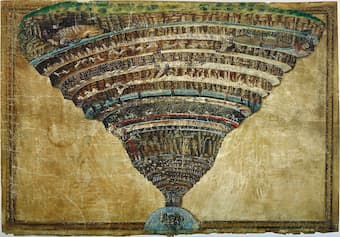
Sandro Botticelli: Chart of Hell
A published preface functioning as a program guided audiences through the composition, but the music continued to challenge audiences for decades to come. George Bernard Shaw reviewed the work in 1885 and wrote, “the manner in which the program was presented by Liszt could just as well represent a London house when the kitchen chimney is on fire.” In terms of musical narrative, the opening movement is entitled “Inferno” and guides us through the nine Circles of Hell. The “Gates of Hell” sing slow recitative-like themes, and at “The Vestibule and First Circle Hell” the music becomes frantic. When Dante and Virgil enter the “Second Circle of Hell,” the infernal “Black Wind” that perpetually shakes the damned greets them. Here we find the tragic love of Francesca, whose adulterous affair with her brother-in-law Paolo cost her life and soul. The “Black Wind” motif returns in the “Seventh Circle of Hell,” and Liszt writes, “this entire passage is intended to be a blasphemous mocking laughter.” The “Eight” and “Ninth Circles of Hell” present slightly varied themes, and Dante and Virgil gradually emerge from Hell. They ascend Mount Purgatorio in the second, initially solemn and tranquil movement. Dante and Virgil ascend the two terraces of Ante-Purgatory, where souls repent their sins. The “Seven Cornices of Mount Purgatory” represent the seven deadly sins, and “Earthly Paradise” guides the soul to Paradise. In the score, Liszt directs that the choir be hidden from the audience in the concluding “Magnificat.” Liszt wrote, “Art cannot portray heaven itself, only its image in the hearts of those souls, which have turned to the light of heavenly grace. Thus for us the radiance is still shrouded, although it increases with the clarity of understanding.”
Friday, September 5, 2025
Schumann-Liszt Widmung
by Anson Yeung

Robert Schumann and Clara Wieck © pages.stolaf.edu
Marked by its technical bravura, Widmung (or Dedication in English) has remained one of the most popular encore pieces in piano recital, allowing pianists to display their virtuosity. However, Widmung is much more than a mere showpiece – containing probably the most passionate music writing and most heartfelt feelings. Written by Robert Schumann in 1840 (this piece was from a set of Lieder called Myrthen, Op.25), this piece was later arranged for piano solo by Franz Liszt. Myrthen was dedicated to Clara Wieck as a wedding gift, as he finally married Clara in September, despite the opposition from Clara’s father (who was also Robert’s piano teacher).
Below is the text of Widmung, written by Friedrich Rückert, with English translation:
Original Text by Friedrich Rückert | English Translation (by Richard Stokes, author of The Book of Lieder (Faber, 2005)) |
Du meine Seele, du mein Herz, | You my soul, you my heart, |
The work starts with a flowing sense of pulse, while the first phrase (“Du meine Seele, du mein Herz”) already captures Schumann’s love for Clara and devotion to the relationship. Here, Schumann sincerely confesses to Clara, declaring how important she is to him. For him, Clara is his angel, his spiritual support, and his entire world. Nevertheless, there is still a sense of fear and insecurity in the music, due to separation and uncertainty about their future. This complex mixture of feelings, as a true and full-bodied representation of love, certainly strengthens the emotional power of the music.
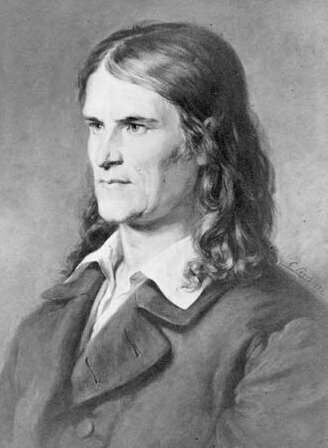
Friedrich Rückert © www.britannica.com
Liszt lengthened the first section by repeating the first theme, but with the melodic line mostly embedded in left hand (with some intertwining) and accompaniment in higher register. Then, the music moves on to the chordal section in E major, which is unchanged in Liszt’s arrangement. The repeated chords convey warmth, tenderness and peace, especially when the text here is associated with death and heaven. Here, the love has changed into everlasting, eternal one – love that transcends space and time.

Franz Liszt © img.wikicharlie.cl
After the brief hand-crossing passage, the music reaches its most technically brilliant and rousing part with arpeggios on right hand and chords highlighting the melodic line on left hand, revealing Schumann’s most intimate feelings. It is the moment when Schumann’s love for Clara becomes so dramatic and uncontrollable, and eventually erupts – a perfect combination of rapture, passion, commitment and sense of elevation. The rich orchestral colours (such as the harp-like figurations, quasi-brass calls) in the music further heightens the emotional intensity. What an outpouring of love here.
In the extended coda, where there are some triumphant chords marked fff, the passion in the music remains, but this time presenting different moods. With ecstatic joy, the music transforms into a declaration, as if Schumann is announcing that he is determined to spend the rest of his lifetime with Clara and willing to make sacrifices in the face of adversity, for Clara is an indescribable miracle of his life.
Friday, August 8, 2025
The Eight Greatest Teachers in Classical Music History?
Us, too. But of course, there’s no way to objectively measure who “the best” teachers are. (Surely the best teachers in your life are the incredible men and women who have taught you over the years.)
Nevertheless, we wanted to try to put together some kind of list addressing the question, so today we’re looking at eight candidates.
If a teacher worked with over half a dozen famous names, they became a candidate for this list. From there, we looked at who had the most impact on the art. After that, we made some subjective choices.
It goes without saying, it was a hard job to narrow a list down to the top eight, but here’s our best shot at it, presented in rough reverse order of influence and importance.
Let us know if you think we got our ranking wrong (or right!).
8) Maria Curcio
Pupils: Martha Argerich, Myung-whun Chung, Simone Dinnerstein, Leon Fleisher, Radu Lupu, Mitsuko Uchida
Maria Curcio – piano teacher, her life and musical philosophy (part 1)
Maria Curcio was born in the summer of 1918. Her father was Italian, and her Jewish-Brazilian mother was a talented pianist.
She began playing piano when she was three years old and was consequently barred by her parents from having a normal childhood. She enrolled in the Naples Conservatory when she was nine years old and graduated at fourteen.
An important moment in her artistic development came in 1933, when she auditioned for the studio of influential pianist Artur Schnabel. Initially, he didn’t want to accept such a young pupil, but when he heard her, he was flabbergasted and claimed she was “one of the greatest talents I have ever met.”

Maria Curcio
In 1939, barely twenty years old, she followed Schnabel’s Jewish secretary Peter Diamand on tour to Amsterdam. While they were there, World War II broke out, and soon the city fell under Nazi control.
The couple went into hiding. Between the stress, poor nutrition, and a tuberculosis infection, Curcio ended the war very sick. The chronic health issues that developed afterwards derailed her performing career for over a decade.
Effectively barred from a performing career, she began teaching more and more. Her studio witnessed a number of the greatest pianists of the twentieth century, and her legacy lives on through them today.
7) Franz Liszt
Pupils: Eugen d’Albert, Hans von Bülow, Amy Fay, Agathe Backer Grøndahl, Sophie Menter, Carl Reinecke, Pauline Viardot, and countless others.
Today, Franz Liszt is remembered primarily as a composer and virtuoso who revolutionised piano technique. But he was also a hugely important mentor for countless nineteenth-century musicians.
According to student Amy Fay, who wrote a book about her European training, Liszt hated being thought of as an official teacher. His teaching arrangements tended to be loose and informal.
But he was incredibly generous with his time and attention, and even those musicians he never taught “officially” soaked in his artistry and technique via listening and conversation. They, in turn, shared what they had learned with their students. His legacy continues today.
In the words of Fay:
Under the inspiration of Liszt’s playing, everybody worked “tooth and nail” to achieve the impossible. A smile of approbation from him was all we cared for. This is how it is that he turned out such a grand school of piano-playing.
He was not afraid, and his pupils are like him. They are not afraid, either, and it is they who have revealed Liszt’s beautiful compositions and brilliant concert style to the world.
It is the direct inheritance of his teaching and example, and even his least eminent pupils have caught something of Liszt’s largeness of horizon.
6) Johann Georg Albrechtsberger
Pupils: Ludwig van Beethoven, John Field, Johann Nepomuk Hummel, Friedrich Kalkbrenner, Ignaz Moscheles, Anton Reicha
Johann Georg Albrechtsberger taught some of the most influential teachers of the nineteenth century, but he is little-known today.
He was born just outside of Vienna in 1736. Initially, he pursued a career in church music. Later, his facility with compositional technique made him a popular teacher in Vienna.
In 1790, he wrote a treatise on compositional theory. After his death, his writings on harmony were published posthumously. These works remained in print for many years.
He died in 1809, never witnessing the full flowering of his best students’ potential.

Johann Georg Albrechtsberger
Without knowing it, Albrechtsberger laid the groundwork for the Romantic era: the revolutionary compositions of Beethoven; the emotional and virtuosic piano playing of Field, Kalkbrenner, and Moscheles; and the pedagogical influence of Anton Reicha, whose time working at the Paris Conservatoire in the 1830s made a huge impact on French music.
5) Carl Reinecke
Pupils: Isaac Albéniz, Max Bruch, Ferruccio Busoni, Edvard Grieg, Leoš Janáček, Amanda Röntgen-Maier, Ethel Smyth, Charles Villiers Stanford
Romantic era music also owes a huge debt to the pupils of Carl Reinecke.
Reinecke was born in the city of Altona, Hamburg, in present-day Germany in 1824. Working under his musician father, he began composing at the age of seven. He gave his first public performance on the piano when he was twelve.
As a young man, he moved to Leipzig, Germany, where he studied under Robert Schumann, Felix Mendelssohn, and Franz Liszt.

Carl Reinecke
In 1860, when he was in his mid-thirties, he was named to the music directorship of the Leipzig Gewandhaus Orchestra. He also took a position teaching piano and composition at the Leipzig Conservatory.
Over his decades of working as a teacher, a truly amazing array of pupils came through his studio, including many who composed in diverse styles influenced by the rising tide of nationalism in music.
Albéniz wrote famously Spanish music; Grieg, of course, took great inspiration from the folk music of Norway; Janáček became one of the most famous Czech composers ever; and Ethel Smyth and Charles Villiers Stanford helped to set the stage for a turn-of-the-century renaissance in British music.
4) Antonio Salieri
Pupils: Ludwig van Beethoven, Carl Czerny, Johann Nepomuk Hummel, Franz Liszt, Giacomo Meyerbeer, Ignaz Moscheles, Maria Theresia von Paradis, Franz Schubert
Thanks to the movie Amadeus, Antonio Salieri is unfairly remembered as “the jealous composer who murdered Mozart.” (There is no evidence that he ever did such a thing.)
He was born in 1750 near Verona in present-day Italy. He began studying the violin with a musically talented brother, and moved to Vienna when he was sixteen.

Antonio Salieri painted by Joseph Willibrord Mähler
He eventually worked his way up to become the preeminent composer of Italian opera in Vienna during the late eighteenth century. (Mozart, being a native-born Austrian, was jealous of Salieri’s success.)
In addition to being a well-respected opera composer, he was also a sought-after teacher. Over the course of his career, he ended up tutoring some of the biggest names in nineteenth-century music, including Beethoven, Liszt, Meyerbeer, and Schubert. During these lessons, he usually focused on addressing vocal writing.
Sadly, Salieri’s mental and physical health declined in his later years. He attempted suicide in 1823 and suffered from dementia until his death in 1825. The monument at his grave is decorated with a poem written by one of his pupils, Joseph Weigl.
3) Dorothy DeLay
Pupils: Sarah Chang, Nigel Kennedy, Anne Akiko Meyers, Midori Goto, Shlomo Mintz, Itzhak Perlman, Nadja Salerno-Sonnenberg, Gil Shaham, Jaap van Zweden
The last fifty years of violin playing would be unrecognisable without the pupils of Dorothy DeLay.
DeLay was born in small-town Kansas in 1917 to a musical family. She began playing the violin when she was four.
She studied at Oberlin Conservatory, Michigan State University, and Juilliard. In 1946, she began working at Juilliard as violin teacher Ivan Galamian’s assistant.
From there, she became an increasingly influential presence. She was deeply beloved for her curiosity, collaborative spirit, and willingness to let her students all develop their own unique creative voices.
Itzhak Perlman, arguably her most famous student, once described her teaching style:
I would come and play for her, and if something was not quite right, it wasn’t like she was going to kill me.
She would ask questions about what you thought of particular phrases—where the top of the phrase was, and so on. We would have a very friendly, interesting discussion about ‘Why do you think it should sound like this?’ and ‘What do you think of that?’
I was not quite used to this way of approaching things.
She died in 2002 at the age of eighty-four. She had led one of the most remarkable teaching careers in the entirety of classical music history.
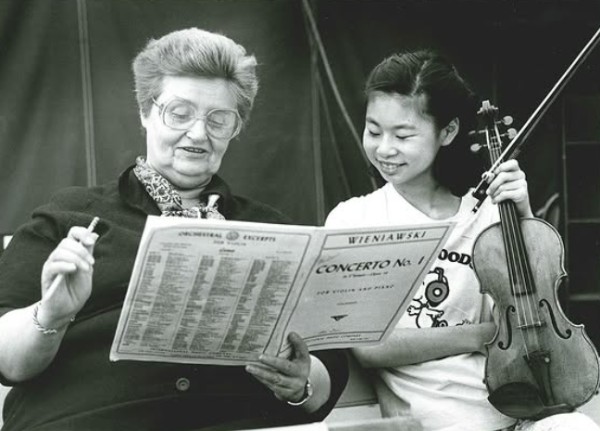
Dorothy DeLay and Midori Goto
2) Mathilde Marchesi
Pupils: Suzanne Adams, Frances Alda, Emma Calvé, Ada Crossley, Emma Eames, Marie Fillunger, Mary Garden, Gabrielle Krauss, Blanche Marchesi, Nellie Melba, Emma Nevada, Sibyl Sanderson
Mathilde Marchesi was born Mathilde Graumann to a musically talented family in Frankfurt, Germany, in 1821.
Her pianist aunt Dorothea von Ertmann was one of Beethoven’s most beloved pupils and creative partners. After his death, Dorothea championed his music, helping to usher it into the canon.
When she was in her early twenties, Mathilde’s family lost their fortune, so she went to seek hers in Vienna and Paris as an opera singer. She made her debut in 1844, but never became a star.
Instead, she married baritone Salvatore Marchesi in 1852, retired from the stage, and shifted her attention to teaching.
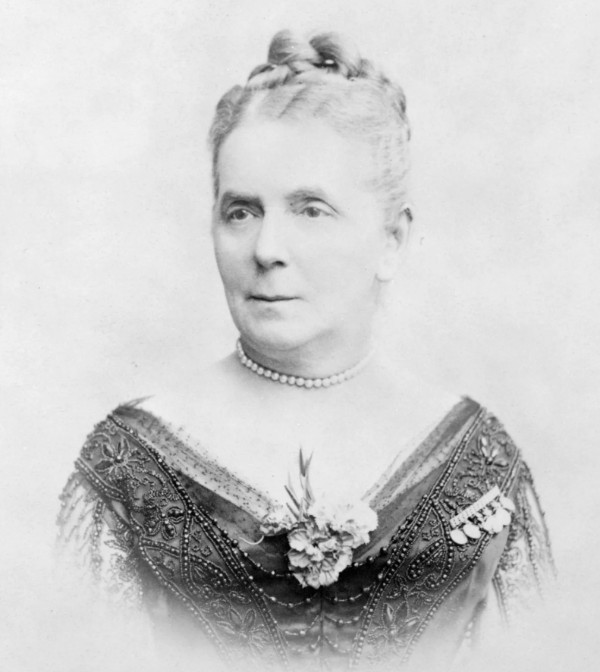
Mathilde Marchesi
She began her teaching career working at the conservatories in Cologne and Vienna. In 1881, when she was sixty, she began her own school in Paris.
She specialised in teaching the bel canto style and valued a more natural attitude than was common at the time.
It is mind-boggling how many famous students she taught. Frances Alda (born 1879) became a famous onstage partner of Caruso. Emma Calvé (born 1858) was considered to be the greatest Carmen of her generation. Ada Crossley (born 1871) was the first recording artist hired by the Victor Talking Machine Company. Mary Garden (born 1874) premiered the role of Mélisande in Debussy’s opera Pelléas et Mélisande. Sibyl Sanderson became one of Jules Massenet’s favourite performers, and she created the role of Thaïs. Dame Nellie Melba (born 1861) was possibly the most famous singer of the Victorian era, period.
The depth and breadth of the accomplishments of her students, and the way they influenced late nineteenth and early twentieth century opera, makes Mathilde Marchesi one of the best teachers in classical music history.
1) Nadia Boulanger
Pupils: George Antheil, Daniel Barenboim, Marion Bauer, Lili Boulanger, Elliott Carter, Aaron Copland, Roy Harris, Gian Carlo Menotti, Ginette Neveu, Astor Piazzolla, Julia Perry, Walter Piston, and countless others
How Nadia Boulanger Raised a Generation of Composers
Nearly every classical music lover can agree: Nadia Boulanger has been the single most influential teacher in classical music history. It’s possible that she’s one of the most influential teachers of all time, period.
Nadia was born in Paris in 1887 to a musical family. Her elderly father, Ernest Boulanger (she was born on his 72nd birthday), was a composer and pianist.
Nadia began studying music when she was five years old. When a sister named Lili arrived five years later, Nadia became devoted to her and her education, too.
Both sisters were incredibly gifted, but Lili was a once-in-a-generation talent. Accordingly, when Nadia began studying at the Paris Conservatoire when she was nine, Lili tagged along with her.
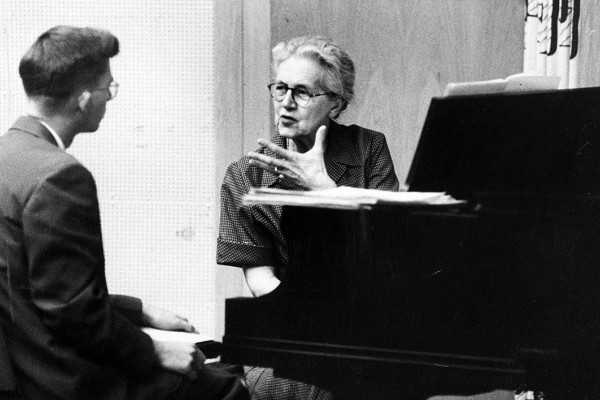
Nadia Boulanger
Nadia dreamed of winning the prestigious Prix de Rome prize: something her father had done in his youth, but which a woman had never done. She came close, but never actually won. Lili ended up breaking that particular glass ceiling in 1913.
Despite her promise, Lili’s health was extremely poor, and she died of Crohn’s disease at the end of World War I.
After her sister’s devastating death, Nadia began gravitating more and more toward teaching instead of composing. She also needed to focus on a field that would guarantee a steady income, in order to support herself and her mother. Consequently, in 1921, she began teaching harmony at the French Music School for Americans in Fontainebleu. One of her first students there would become one of her most famous: Aaron Copland.
Copland would later write of her:
Nadia Boulanger knew everything there was to know about music; she knew the oldest and the latest music, pre-Bach and post-Stravinsky.
All technical know-how was at her fingertips: harmonic transposition, the figured bass, score reading, organ registration, instrumental techniques, structural analyses, the school fugue and the free fugue, the Greek modes and Gregorian chant.
Nadia was blunt about her talent for analysis:
I can tell whether a piece is well-made or not, and I believe that there are conditions without which masterpieces cannot be achieved, but I also believe that what defines a masterpiece cannot be pinned down. I won’t say that the criterion for a masterpiece does not exist, but I don’t know what it is.
Her decades of teaching were not without controversy. She could be emotionally abusive and held ideas that today would be considered offensively sexist. She was also accused of advancing students whom she liked personally and making other students’ lives miserable.
Despite those and other shortcomings, she is unquestionably the most influential music teacher of all time. Classical music as we know it today would not exist without her, period.
Friday, July 18, 2025
What Was It Like Being Liszt’s Student?
by Emily E. Hogstad
She studied at the New England Conservatory of Music in the 1860s and, in 1869, took the daring transoceanic journey to further her studies in Germany.
While in Europe, she studied with Liszt’s student Carl Tausig, as well as Liszt himself.
Her letters to her sister served as the foundation for her book Music Study in Germany, which was published in 1880, and offers a tantalising glimpse into what it was like to be around Liszt in the 1870s.
Today, we’re looking at some of the best stories from Fay’s book.
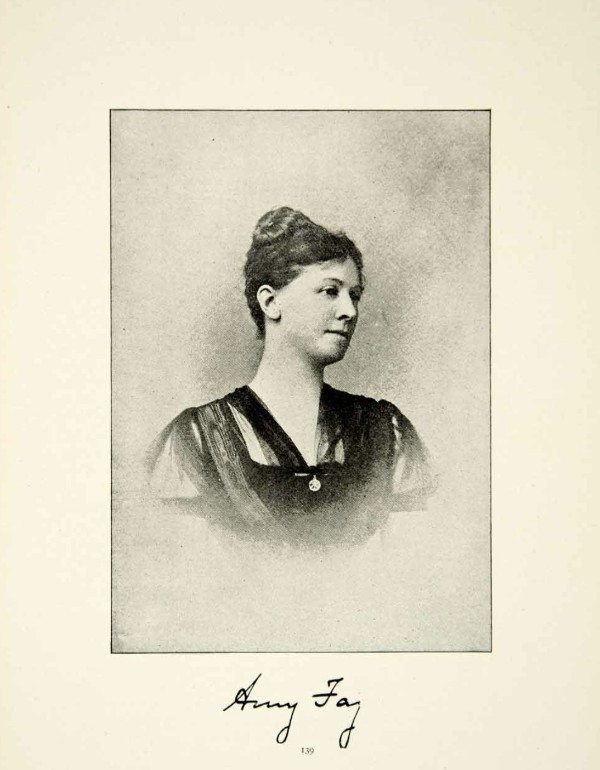
Amy Fay
Liszt could flirt and watch a play simultaneously.
Last night I arrived in Weimar, and this evening I have been to the theatre, which is very cheap here, and the first person I saw, sitting in a box opposite, was Liszt, from whom, as you know, I am bent on getting lessons, though it will be a difficult thing I fear, as I am told that Weimar is overcrowded with people who are on the same errand.
I recognised Liszt from his portrait, and it entertained and interested me very much to observe him.
He was making himself agreeable to three ladies, one of whom was very pretty.
He sat with his back to the stage, not paying the least attention, apparently, to the play, for he kept talking all the while himself, and yet no point of it escaped him, as I could tell by his expression and gestures.
Liszt was “the most striking-looking man imaginable.”
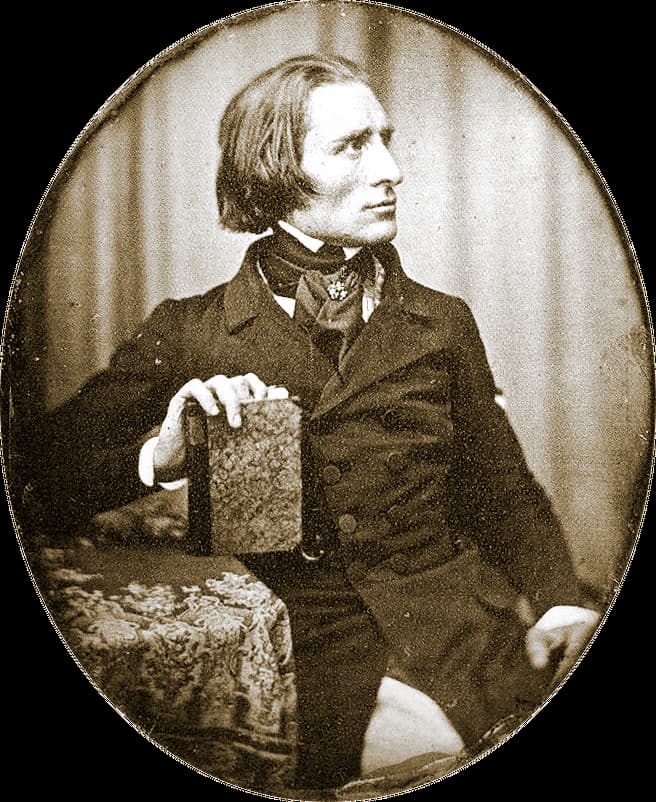
Hermann Biow: Franz Liszt, 1943
Liszt is the most interesting and striking-looking man imaginable.
Tall and slight, with deep-set eyes, shaggy eyebrows, and long iron-grey hair, which he wears parted in the middle.
His mouth turns up at the corners, which gives him a most crafty and Mephistophelean expression when he smiles, and his whole appearance and manner have a sort of Jesuitical elegance and ease.
His hands are very narrow, with long and slender fingers that look as if they had twice as many joints as other people’s. They are so flexible and supple that it makes you nervous to look at them.
Anything like the polish of his manner, I never saw. When he got up to leave the box, for instance, after his adieux to the ladies, he laid his hand on his heart and made his final bow,—not with affectation, or in mere gallantry, but with a quiet courtliness which made you feel that no other way of bowing to a lady was right or proper. It was most characteristic.
Liszt didn’t actually think of himself as a teacher.
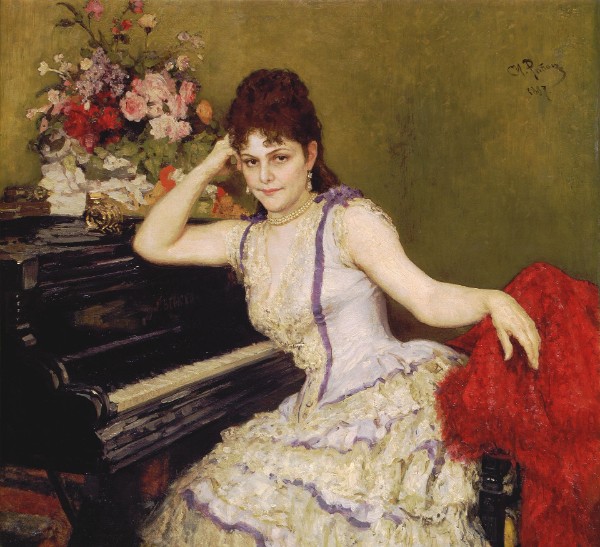
Sophie Menter
He asked me if I had been to Sophie Menter’s concert in Berlin the other day.
I said yes. He remarked that Miss Menter was a great favourite of his…
I asked him if Sophie Menter was a pupil of his. He said no, he could not take the credit of her artistic success to himself.
I heard afterwards that he really had done ever so much for her, but he won’t have it said that he teaches!
Later, Fay writes:
He says “people fly in his face by dozens,” and seems to think he is “only there to give lessons.”
He gives no paid lessons whatever, as he is much too grand for that, but if one has talent enough, or pleases him, he lets one come to him and play to him.
Liszt inspired and encouraged his pupils to develop their own artistic identities.
Nothing could exceed Liszt’s amiability, or the trouble he gave himself, and instead of frightening me, he inspired me. Never was there such a delightful teacher! and he is the first sympathetic one I’ve had.
You feel so free with him, and he develops the very spirit of music in you. He doesn’t keep nagging at you all the time, but he leaves you your own conception.
Now and then, he will make a criticism, or play a passage, and with a few words give you enough to think of all the rest of your life.
There is a delicate point to everything he says, as subtle as he is himself. He doesn’t tell you anything about the technique. You must work this out for yourself.
When I had finished the first movement of the sonata, Liszt, as he always does, said “Bravo!”
Liszt was a difficult artist to turn pages for because he sight-read so quickly.
He made me come and turn the leaves. Gracious! how he does read!
It is very difficult to turn for him, for he reads ever so far ahead of what he is playing, and takes in fully five bars at a glance, so you have to guess about where you think he would like to have the page over.
Once I turned it too late, and once too early, and he snatched it out of my hand and whirled it back.
We know exactly what Liszt’s quarters in Weimar looked like.
It is so delicious in that room of his! It was all furnished and put in order for him by the Grand Duchess herself.
The walls are pale grey, with a gilded border running round the room, or rather two rooms, which are divided, but not separated, by crimson curtains.
The furniture is crimson, and everything is so comfortable—such a contrast to German bareness and stiffness generally.
A splendid grand piano stands in one window (he receives a new one every year). The other window is always wide open and looks out on the park.
There is a dove-cote just opposite the window, and the doves promenade up and down on the roof of it, and fly about, and sometimes whirr down on the sill itself. That pleases Liszt.
His writing table is beautifully fitted up with things that all match. Everything is in bronze – ink-stand, paper-weight, match-box, etc., and there is always a lighted candle standing on it by which he and the gentlemen can light their cigars.
There is a carpet on the floor, a rarity in Germany, and Liszt generally walks about, and smokes, and mutters (he can never be said to talk), and calls upon one or other of us to play.
Liszt was fully aware of how his charisma affected his audiences.
Liszt knows well the influence he has on people, for he always fixes his eyes on some of us when he plays, and I believe he tries to wring our hearts.
When he plays a passage and goes pearling down the keyboard, he often looks over at me and smiles to see whether I am appreciating it.
Liszt enjoyed telling people about the time that Chopin put on a wig to impersonate him.
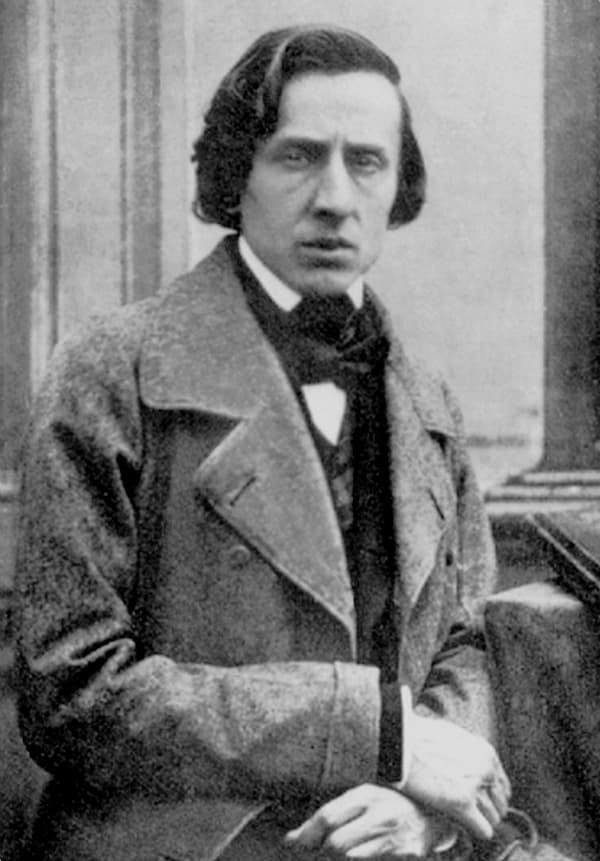
Frédéric Chopin
It was the first time I ever heard Liszt really talk, for he contents himself mostly with making little jests. He is full of esprit.
We were speaking of the faculty of mimicry, and he told me such a funny little anecdote about Chopin.
He said that when he and Chopin were young together, somebody told him that Chopin had a remarkable talent for mimicry, and so he said to Chopin, “Come round to my rooms this evening and show off this talent of yours.”
So Chopin came. He had purchased a blonde wig (“I was very blonde at that time,” said Liszt), which he put on, and got himself up in one of Liszt’s suits.
Presently an acquaintance of Liszt’s came in, Chopin went to meet him instead of Liszt, and took off his voice and manner so perfectly, that the man actually mistook him for Liszt, and made an appointment with him for the next day—”and there I was in the room,” said Liszt. Wasn’t that remarkable?
Liszt actually played wrong notes, but he enjoyed doing so, and knew how to get out of them.
Liszt sometimes strikes wrong notes when he plays, but it does not trouble him in the least. On the contrary, he rather enjoys it.
He reminds me of one of the cabinet ministers in Berlin, of whom it is said that he has an amazing talent for making blunders, but a still more amazing one for getting out of them and covering them up.
Of Liszt the first part of this is not true, for if he strikes a wrong note it is simply because he chooses to be careless. But the last part of it applies to him eminently.
It always amuses him instead of disconcerting him when he comes down squarely wrong, as it affords him an opportunity of displaying his ingenuity and giving things such a turn that the false note will appear simply a key leading to new and unexpected beauties.
An accident of this kind happened to him in one of the Sunday matinees, when the room was full of distinguished people and of his pupils. He was rolling up the piano in arpeggios in a very grand manner indeed, when he struck a semi-tone short of the high note upon which he had intended to end.
I caught my breath and wondered whether he was going to leave us like that, in mid-air, as it were, and the harmony unresolved, or whether he would be reduced to the humiliation of correcting himself like ordinary mortals, and taking the right chord.
A half smile came over his face, as much as to say—”Don’t fancy that this little thing disturbs me,”—and he instantly went meandering down the piano in harmony with the false note he had struck, and then rolled deliberately up in a second grand sweep, this time striking true.
I never saw a more delicious piece of cleverness. It was so quick-witted and so exactly characteristic of Liszt. Instead of giving you a chance to say, “He has made a mistake,” he forced you to say, “He has shown how to get out of a mistake.”
Wednesday, April 9, 2025
Top 10 Romantic composers
Top 10 Romantic composers
Gramophone
Thursday, January 2, 2025
The Romantic period was one of the most innovative in music history, characterised by lyrical melodies, rich harmonies, and emotive expression. Here's our beginner's guide to the greatest composers of the Romantic period

Hector Berlioz (1803-69)
The arch-Romantic composer, Hector Berlioz’s life was all you’d expect – by turn turbulent and passionate, ecstatic and melancholic.
Key recording:
Les Troyens
Sols incl DiDonato, Spyres, Lemieux; Strasbourg Philharmonic Orchestra / John Nelson (Gramophone's 2018 Recording of the Year) Read the review
Explore Berlioz:
Top 10 Berlioz albums – 10 great Berlioz recordings by Sir Colin Davis, John Nelson, Régine Crespin, Robin Ticciati and more
● Top 10 Classical era composers
● Top 10 Renaissance composers

Fryderyck Chopin (1810-49)
Few composers command such universal love as Fryderyck Chopin; even fewer still have such a high proportion of all their music in the active repertoire. Yet he is the only great composer who wrote no symphonies, operas, ballets or choral works. His chief claim to immortality relies not on large scale works but on miniature forms.
Key recording:
Piano Concertos No 1 & 2
Martha Argerich pf Montreal Symphony Orchestra / Charles Dutoit (winner of the Gramophone Concerto Award in 1999) Read the review
Explore Chopin:
The 10 greatest Chopin pianists – Stephen Plaistow recalls the illustrious recorded history of Chopin's oeuvre and offers a personal view of great Chopin interpreters.

Robert Schumann (1810-56)
Robert Schumann is a key figure in the Romantic movement; none investigated the Romantic’s obsession with feeling and passion quite so thoroughly as him. Schumann died insane, but then some psychologists argue that madness is a necessary attribute of genius.
Key recording:
Symphonies Nos 1-4
Chamber Orchestra of Europe / Yannick Nézet‑Séguin (Editor's Choice, May 2014) Read the review
Explore Schumann:
Robert Schumann: the story of his prolific ‘year of song’ – Richard Wigmore explores the music of and biography behind Robert Schumann’s miraculous year of song, 1840

Franz Liszt (1811-86)
Composer, teacher, Abbé, Casanova, writer, sage, pioneer and champion of new music, philanthropist, philosopher and one of the greatest pianists in history, Franz Liszt was the very embodiment of the Romantic spirit. He worked in every field of music except ballet and opera and to each field he contributed a significant development.
Key recording:
'Transcendental: Daniil Trifonov plays Franz Liszt'
Daniil Trifonov pf (Recording of the Month, October 2016; shortlisted for Instrumental Award 2017) Read the review
Explore Liszt:
Podcast: exploring the music of Liszt – Editor Martin Cullingford is joined by Gramophone writer and expert on both Liszt and the piano, Jeremy Nicholas to discuss the composers's greatest works, and the greatest recordings of his music.

Richard Wagner (1813-83)
No composer has had so deep an influence on the course of his art, before or since. Entrepreneur, philosopher, poet, conductor, one of the key composers in history and most remarkable men of the 19th century, Richard Wagner knew he was a genius. He was also an unpleasant, egocentric and unscrupulous human being.
Key recording:
Parsifal
Sols incl Jess Thomas, George London, Hans Hotter; Bayreuth Festival Chorus & Orchestra / Hans Knappertsbusch Read the review
Explore Wagner:
The Gramophone Collection: Wagner's Ring – Mike Ashman visits the musical immortals and the younger gods of today to deliver his verdict on the complete Ring on record.

Giuseppe Verdi (1813-1901)
Giuseppe Verdi was never a theoretician or academic, though he was quite able to write a perfectly poised fugue if he felt inclined. What makes him, with Puccini, the most popular of all opera composers is the ability to dream up glorious melodies with an innate understanding of the human voice, to express himself directly, to understand how the theatre works, and to score with technical brilliance, colour and originality.
Key recording:
Aida
Sols incl Anja Harteros, Jonas Kaufmann, Ekaterina Semenchuk; Coro dell'Accademia Nazionale Di Santa Cecilia, Orchestra dell'Accademia Nazionale di Santa Cecilia / Antonio Pappano (winner of the 2016 Gramophone Opera Award; Recording of the Month, Awards issue 2015) Read the review
Explore Verdi:
Verdi's Otello: a guide to the best recordings – Richard Lawrence finds at least three very special Otellos, and some electric conducting.

Anton Bruckner (1824-96)
Anton Bruckner’s reputation rests almost entirely with his symphonies – the symphonies, someone said, that Wagner never wrote.
Key recording:
Symphony No 9
Lucerne Festival Orchestra / Claudio Abbado (Gramophone's 2015 Recording of the Year) Read the review
Explore Bruckner:
Top 10 Bruckner recordings – A beginner's guide to the music of one of the great symphonic composers.

Giacomo Puccini (1858-1924)
Whatever the atmosphere he wanted to create, Giacomo Puccini’s sound world is unique and unmistakeable with its opulent yet clear-cut orchestration and a miraculous fund of melodies with their bittersweet, tender lyricism. His masterly writing for the voice guarantees the survival of his music for many years to come.
Key recording:
Tosca
Sols incl Maria Callas, Giuseppe di Stefano, Tito Gobbi; Orchestra and Chorus of La Scala Milan / Victor de Sabata Read the review
Explore Puccini:
Maria Callas: the Tosca sessions – Maria Callas’s famous 1953 Tosca, as Christopher Cook reveals for the first time, was riven by tension and driven by a relentless quest for perfection.

Pyotr Il'yich Tchaikovsky (1840-93)
Tchaikovsky is the most popular of all Russian composers, his music combining some nationalist elements with a more cosmopolitan view, but it is music that could only have been written by a Russian. In every genre he shows himself to be one of the greatest melodic fountains who ever lived.
Key recording:
Symphony No 6, Pathétique
MusicAeterna / Teodor Currentzis (Recording of the Month, January 2018) Read the review
Explore Tchaikovsky:
Tchaikovsky's 1812 Overture: the complete guide – How audiences, performers and the composer himself have responded to this iconic and surprisingly controversial work, by Geoffrey Norris.

Johannes Brahms (1833-97)
One of the giants of classical music, Johannes Brahms appeared to arrive fully armed, found a style in which he was comfortable – traditional structures and tonality in the German idiom – and stuck to it throughout his life. He was no innovator, preferring the logic of the symphony, sonata, fugue and variation forms.
Key recording:
Symphonies (Complete)
Gewandhaus Orchestra / Riccardo Chailly (Gramophone's 2014 Recording of the Year) Read the review
Explore Brahms:
Brahms's Symphony No 3: a guide to the best recordings – Richard Osborne surveys the finest recordings of the Third Symphony